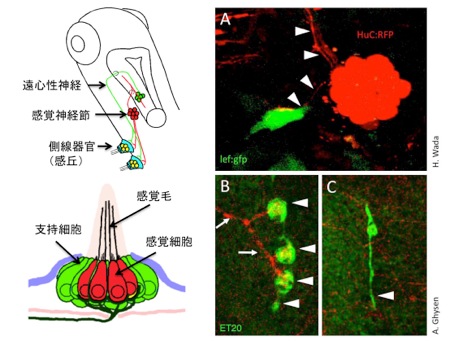Innervation is required for sense organ development
Division of Molecular and Developmental Biology・Kawakami Group
Hironori Wada, Christine Dambly-Chaudiere, Koichi Kawakami, and Alain Ghysen
PNAS, 2013 Apr 2;110(14):5659-5664. DOI: 10.1073/pnas.1214004110
Various types of sense organs are distributed over the body surface. These organs are innervated by sensory axons, thereby transmit information to the central nervous system. Many sense organs emit molecules required for proper growth or guidance of the axons. However, roles of the axons for development of sense organs remain poorly understood. In this study, we reveal that proliferation of the mechanosensory organs (neuromasts) of fish is promoted by axonal innervation.
In adult zebrafish, the neuromasts give rise to new neuromasts by budding and generate a cluster of organs. The budding cells, that show high Wnt signaling activity, are associated by side branches of axons extended from the founder neuromast (Fig. 1A). To analyze the role of innervation, we ablated sensory neurons in larvae. The neuromast sent off budding cells normally, but subsequent cell proliferation to generate new sense organs did not take place (Fig. 1B,C). We propose that the axon promotes Wnt signaling activity, which is required for the proliferate phase that leads to sense organ formation.
This study was carried out in collaboration with Dr. Alain Ghysen (Montpellier University) and funded by the PRESTO of the Japan Science and Technology Agency.

(A) The lateral line sense organ, neuromast, sends off proliferative bud cells, that show high Wnt signaling activity. Axons are indicated by arrowheads.
(B, C) The cell proliferation does not take place in the absence of the sensory axons.















